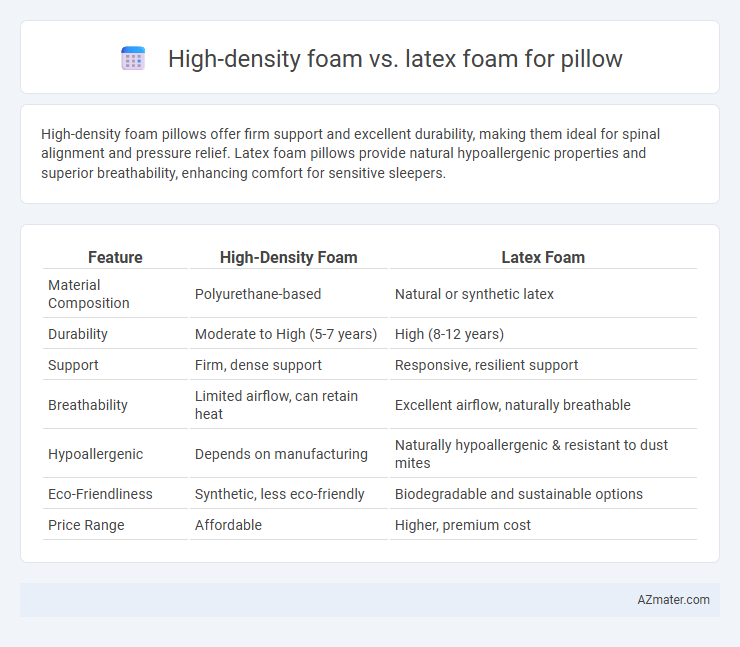High-density foam pillows offer firm support and excellent durability, making them ideal for spinal alignment and pressure relief. Latex foam pillows provide natural hypoallergenic properties and superior breathability, enhancing comfort for sensitive sleepers.
Table of Comparison
| Feature | High-Density Foam | Latex Foam |
|---|---|---|
| Material Composition | Polyurethane-based | Natural or synthetic latex |
| Durability | Moderate to High (5-7 years) | High (8-12 years) |
| Support | Firm, dense support | Responsive, resilient support |
| Breathability | Limited airflow, can retain heat | Excellent airflow, naturally breathable |
| Hypoallergenic | Depends on manufacturing | Naturally hypoallergenic & resistant to dust mites |
| Eco-Friendliness | Synthetic, less eco-friendly | Biodegradable and sustainable options |
| Price Range | Affordable | Higher, premium cost |
Understanding High-Density Foam Pillows
High-density foam pillows offer superior support by maintaining firmness and shape over time, making them ideal for individuals needing consistent neck and spine alignment. This type of foam is denser and more durable than latex, providing enhanced pressure relief and reducing the risk of sagging. While latex foam is naturally hypoallergenic and breathable, high-density foam's ability to contour closely to the head and neck ensures personalized comfort and long-lasting performance.
What is Latex Foam?
Latex foam is a natural or synthetic material derived from rubber tree sap, known for its resilience, breathability, and hypoallergenic properties, making it a popular choice for pillows. Unlike high-density foam, latex foam offers superior elasticity and durability while maintaining consistent support and pressure relief throughout the night. Its open-cell structure allows for enhanced airflow, promoting a cooler sleeping experience compared to the denser, heat-retaining properties of traditional memory foam pillows.
Support and Comfort Comparison
High-density foam pillows offer firm support by contouring closely to the head and neck, promoting spinal alignment and reducing pressure points, ideal for back and side sleepers seeking stability. Latex foam pillows provide a responsive, buoyant feel with natural elasticity, delivering excellent support with enhanced airflow and durability, making them suitable for sleepers requiring a balance of comfort and breathability. Both materials excel in support, but latex foam often outperforms in long-term comfort due to its resilience and hypoallergenic properties.
Durability and Longevity
High-density foam pillows offer exceptional durability, maintaining their shape and support for several years without significant sagging or degradation. Latex foam pillows excel in longevity due to their natural resilience and resistance to dust mites and mold, often lasting up to a decade with proper care. Both materials provide long-lasting comfort, but latex foam generally outperforms high-density foam in durability and extended use.
Breathability and Temperature Regulation
High-density foam pillows provide firm support but tend to retain heat due to their dense cell structure, limiting breathability and resulting in less effective temperature regulation. Latex foam pillows offer superior airflow with an open-cell design and natural ventilation properties, enhancing breathability and maintaining a cooler sleeping surface. Choosing latex foam improves thermal comfort by allowing heat dissipation and moisture wicking, making it ideal for hot sleepers compared to the heat retention commonly experienced with high-density foam.
Allergen Resistance and Hypoallergenic Properties
Latex foam pillows offer superior allergen resistance due to their natural antimicrobial and dust mite resistant properties, making them highly suitable for allergy sufferers. High-density foam pillows, while supportive and durable, can sometimes harbor allergens unless treated with hypoallergenic coatings or encased in protective covers. Choosing latex foam provides a more naturally hypoallergenic option, minimizing risks related to mold, mildew, and dust mites.
Maintenance and Care Differences
High-density foam pillows require regular airing to prevent moisture buildup and can be spot-cleaned with mild detergent, but they should not be fully immersed in water to maintain structural integrity. Latex foam pillows are naturally resistant to dust mites and mold, making maintenance easier, and they can be gently wiped with a damp cloth without risking damage. Both foam types benefit from the use of breathable pillow covers to enhance hygiene and prolong their lifespan.
Environmental Impact and Sustainability
High-density foam pillows are often derived from petrochemicals, resulting in higher carbon footprints and limited biodegradability, whereas latex foam pillows typically use natural rubber sourced from rubber trees, promoting sustainability through renewable materials. Latex foam's biodegradability and ability to be recycled or composted contribute to reduced landfill waste compared to synthetic high-density foam, which can persist in the environment for decades. The cultivation of rubber trees also supports carbon sequestration and sustainable farming practices, making latex foam pillows a more eco-friendly choice for environmentally conscious consumers.
Price and Value Considerations
High-density foam pillows typically offer affordable pricing with durable support, making them a cost-effective choice for budget-conscious consumers seeking firm comfort. Latex foam pillows, while higher in price due to natural materials and hypoallergenic properties, provide exceptional resilience and long-term value through enhanced breathability and durability. Evaluating factors like price per lifespan and specific sleep needs helps determine the best value between high-density and latex foam pillows.
Which Foam is Best for Your Sleep Needs?
High-density foam provides firm support and excellent durability, ideal for sleepers who need spinal alignment and pressure relief. Latex foam offers a responsive, breathable surface with natural hypoallergenic properties, making it suitable for hot sleepers and allergy sufferers. Choosing between high-density and latex foam depends on your preferred firmness, sleep temperature, and sensitivity to allergens.

Infographic: High-density foam vs Latex foam for Pillow
 azmater.com
azmater.com